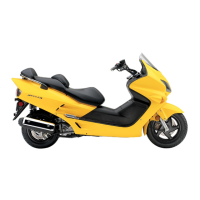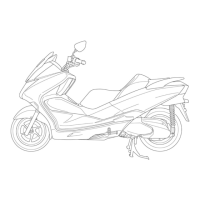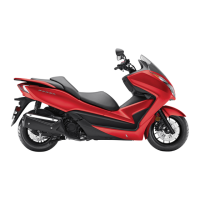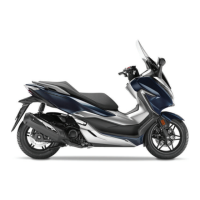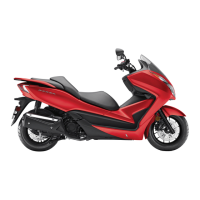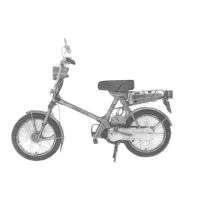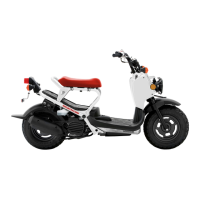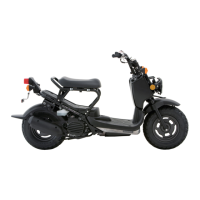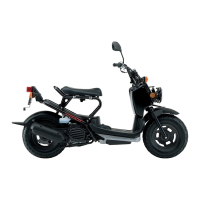
Do you have a question about the Honda NSS250 Reflex 2001-2007 and is the answer not in the manual?
| Displacement | 249 cc |
|---|---|
| Cooling System | Liquid-cooled |
| Bore x Stroke | 72.7 mm x 60.0 mm |
| Compression Ratio | 10.5:1 |
| Ignition | CDI |
| Starter | Electric |
| Transmission | Automatic V-Matic belt drive |
| Front Brake | Single disc |
| Rear Brake | Single disc |
| Front Tire | 110/90-13 |
| Rear Tire | 130/70-12 |
| Width | 745 mm (29.3 inches) |
| Engine Type | Liquid-cooled single-cylinder four-stroke |
| Final Drive | V-belt |
| Front Suspension | 33 mm hydraulic fork |
| Rear Suspension | Twin shock |
General safety warnings and important precautions for servicing the motorcycle.
Information regarding safe servicing practices and necessary precautions for technicians.
Guidance on using the manual, including section references and table of contents structure.
Explanation of symbols used in the manual to denote specific service procedures and information.
Guidelines for performing service procedures and using genuine Honda parts.
Information on identifying different models and their specific details.
Key technical specifications for the motorcycle, including dimensions and capacities.
Recommended torque specifications for various fasteners and components.
Locations and types of lubricants and sealants for proper maintenance.
Overview of emission control systems, including source of emissions and crankcase control.
Detailed specifications for engine, frame, and drivetrain components.
Technical specifications for engine components like cylinder head, piston, and clutch parts.
Specifications for suspension, steering, and hydraulic brake systems.
Specifications for battery, charging system, ignition, and lighting systems.
Details on engine parts like cylinder head, valves, piston, and clutch assembly.
Information on frame parts, including body panels, suspension, and steering.
Details on front and rear hydraulic brake systems, including specifications.
Specifications and details for electrical systems like battery, ignition, and lights.
Overview of ABS components, including sensors, modulator, and system diagrams.
Details on the ignition system, including spark plug, ignition coil, and timing.
Information on the battery and charging system, including testing and charging procedures.
Details on lights, meters, and various switches used on the motorcycle.
Information on the electric starter motor, relay, and switch components.
Diagrams illustrating the routing of electrical cables and harnesses on the motorcycle.
Schematic diagrams showing the electrical wiring of the motorcycle for different models.
Information about emission control labels and their placement on the vehicle.
Diagram showing the locations of various body panels on the motorcycle.
Chart detailing the order for removing body panels and their associated components.
General service information, torque values, and troubleshooting for frame and body panels.
Step-by-step instructions for removing and installing trim clips.
Instructions for removing and installing the seat, floor mat, and floor skirt.
Procedures for removing and installing the rear spoiler and body covers.
Steps for removing and installing the main body cover and rear center cover.
Instructions for removing and installing the upper and lower luggage boxes.
Procedures for removing and installing the floor board, including fuel tank components.
Steps for removing and installing the windshield and its garnish.
Instructions for removing and installing the backrest and grab rail.
Procedures for removing and installing the front cover and front meter visor.
Steps for removing and installing the front lower cover and trim clips.
Instructions for removing and installing the inner cover and under cover.
Steps for removing and installing the handlebar cover and muffler.
General service info, specifications for fuel, spark plug, and recommended fluids.
Key torque values for various maintenance tasks and components.
Recommended maintenance intervals based on mileage and time.
Procedures for inspecting and maintaining the fuel line and fuel filter.
Checking and adjusting throttle operation, including grip free play.
Instructions for inspecting and replacing the air cleaner element.
Procedures for inspecting, cleaning, and replacing the spark plug.
How to inspect and adjust valve clearance on the engine.
Procedure for checking and maintaining the engine oil level.
Steps for cleaning and maintaining the engine oil strainer screen.
Procedure for adjusting the engine's idle speed.
Checking the coolant level in the radiator and reserve tank.
Inspection of the cooling system, including hoses and radiator passages.
Inspection of the secondary air supply system for proper function.
Inspection of the evaporative emission control system components.
Procedure for checking the final drive oil level.
Instructions for changing the final drive oil and recommended oil type.
Guidance on checking and replacing brake fluid, including air bleeding.
Procedures for inspecting front and rear brake pad wear.
Checking the operation of the parking brake system.
Instructions for adjusting the headlight aim according to regulations.
Checking the side stand for proper operation and spring condition.
Inspection of front and rear suspension components for wear and damage.
Ensuring all chassis nuts and bolts are tightened to specified torque values.
Checking tire pressure, tread depth, and wheel trueness.
Checking steering head bearings for smooth operation and proper tension.
Diagram illustrating the flow of oil through the engine's lubrication system.
General service info, specifications for engine oil capacity, and recommended oil.
Recommended torque values for engine oil drain bolt and oil cap screw.
List of specialized tools for lubrication system maintenance.
Step-by-step instructions for removing the engine oil pump.
Disassembly of the oil pump and inspection of its internal components for wear.
Instructions for assembling the engine oil pump with new parts and proper lubrication.
Procedures for installing the assembled oil pump onto the engine crankcase.
General service info, specifications, torque values, and troubleshooting for the fuel system.
Specifications for the carburetor, including identification and settings.
List of specialized tools for fuel system maintenance.
Diagnosing and solving common issues with the fuel system, like starting problems or poor performance.
Steps for removing and installing the air cleaner housing.
Detailed instructions for removing the motorcycle's carburetor.
Step-by-step guide for disassembling the carburetor into its individual components.
Procedures for inspecting and testing the Starting Enrichment (SE) valve.
Inspection of the carburetor's vacuum chamber and its components.
Inspection of the float chamber, float valve, and jets for wear or damage.
Procedures for inspecting the air cut-off valve and cleaning the carburetor.
Instructions for reassembling the carburetor after cleaning or repairs.
Assembling the float chamber and inspecting the float level.
Assembling the float chamber and vacuum chamber components with new seals.
Installing the diaphragm, SE valve, and chamber cover correctly.
Procedures for installing the carburetor back onto the motorcycle.
Connecting throttle cables, air cleaner housing, and luggage box for carburetor installation.
Inspection and operation check of the starting enrichment (SE) valve.
Procedure for adjusting the pilot screw for proper idle speed.
Adjusting the pilot screw for high altitude operation and emission control updates.
Inspection of the secondary air supply system, focusing on air ports and vacuum.
Procedure for inspecting the PAIR check valve and its components.
Inspection of the evaporative emission control system, including canister and purge control valve.
Procedures for removing and installing the fuel tank and its related components.
Diagram illustrating the coolant flow through the cooling system.
General service info, coolant capacity, recommended antifreeze, and specifications.
Torque specifications for water pump impeller, thermosensor, and fan motor switch.
List of specialized tools for cooling system maintenance.
Diagnosing common cooling system issues like overheating or leaks.
Procedure for testing coolant specific gravity using a hydrometer.
Inspecting the radiator cap and system pressure for leaks.
Preparation steps for coolant replacement, including notices and recommended mixtures.
Steps for replacing coolant and bleeding air from the cooling system.
Procedures for removing and installing the engine thermostat.
Inspecting the thermostat for proper operation and temperature.
Checking the water pump for signs of coolant leakage and mechanical seal condition.
Step-by-step instructions for removing the water pump assembly.
Procedures for replacing the water pump's mechanical seal and bearing.
Installing the water pump, including seals, bearings, and impeller.
Steps for installing the water pump cover and connecting the radiator hose.
Procedures for removing and installing the radiator and its associated components.
Instructions for removing, disassembling, and assembling the cooling fan and motor.
Steps for removing and installing the radiator reserve tank.
General service info, specifications, and torque values for engine removal and installation.
Key torque values for engine mounting bolts and related components.
List of specialized tools required for engine removal and installation procedures.
Detailed steps for safely removing the engine from the motorcycle frame.
Disconnecting various hoses, cables, and mounts during engine removal.
Removing engine mount nuts, bolts, and bushings, and inspecting for wear.
Procedures for removing the engine hanger bracket, tension rod, and associated hardware.
Disassembling the engine hanger bracket and inspecting its parts for wear.
Assembling the engine hanger bracket and sub-bracket with proper torque.
Installing the engine hanger bracket assembly onto the frame.
Adjusting and installing the engine hanger bracket and lock nut.
Installing the tension rod, rubber stoppers, and engine mount bolt.
Connecting various components like brake calipers, hoses, and starter motor during engine installation.
Connecting electrical components, installing accessories, and filling fluids after engine installation.
General service info, specifications for cylinder compression, valve clearance, and rocker arms.
Recommended torque values for cylinder head components.
List of specialized tools for cylinder head maintenance.
Diagnosing issues like low compression, excessive noise, or smoke related to the cylinder head.
Procedure for performing a cylinder compression test to assess engine health.
Steps for removing the cylinder head cover to access internal components.
Procedures for removing the camshaft and inspecting its components for wear.
Inspecting the camshaft, bearings, and cam lobes for wear and proper function.
Detailed steps for removing the cylinder head from the engine block.
Disassembling the cylinder head and servicing valve springs and seals.
Inspecting valve springs for free length and valve stems/guides for wear.
Procedures for replacing valve guides using specialized tools.
Inspecting and refacing valve seats for proper sealing and wear.
Detailed steps for refacing valve seats using different angled cutters.
Assembling the cylinder head with valves, springs, seals, and retainers.
Installing the cylinder head onto the engine block, including gasket and bolts.
Installing the camshaft, timing chain, and related components into the cylinder head.
Final steps for camshaft installation, including timing marks and holder bolts.
Installing the cam chain adjuster and securing it with the specified torque.
Installing the cylinder head cover, including rocker arms, O-rings, and bolts.
General service info, specifications for cylinder, piston, and rings, and torque values.
List of specialized tools for cylinder and piston maintenance.
Diagnosing issues like low compression, excessive smoke, or abnormal noise related to cylinder/piston.
Steps for removing the cylinder and piston assembly from the engine.
Inspecting piston rings for movement and measuring end gap, and checking piston pin.
Measuring piston pin dimensions, piston pin hole, and cylinder warpage.
Procedures for replacing cylinder stud bolts with specified torque.
Instructions for correctly installing piston rings onto the piston.
Installing the piston and cylinder assembly onto the crankcase.
General service info, specifications for clutch, drive belt, and pulley dimensions.
Recommended torque values for clutch/driven pulley and related nuts.
List of specialized tools for drive pulley and clutch maintenance.
Diagnosing problems like scooter not moving, poor performance, or abnormal noise.
Steps for removing the left crankcase cover to access the drive components.
Procedure for removing the belt case air cleaner.
Instructions for installing the left crankcase cover and belt case air cleaner.
Step-by-step instructions for removing the drive pulley assembly.
Inspecting the drive belt for wear and weight rollers for damage.
Checking the movable drive face for wear and measuring its boss O.D.
Assembling the drive pulley with weight rollers, slide pieces, and ramp plate.
Installing the drive pulley assembly, drive belt, and face nut.
Procedures for removing the clutch/driven pulley assembly.
Disassembling the clutch assembly, including shoes, springs, and side plates.
Disassembling the driven pulley and replacing its needle bearing.
Inspecting the clutch outer for wear and the clutch shoe lining for thickness.
Checking the driven face spring free length and the driven face for damage.
Assembling the clutch and driven pulley components with proper lubrication.
Final steps for assembling the clutch and driven pulley, including seals and spring.
Installing clutch shoes, springs, and side plates onto the drive plate.
Assembling the clutch/driven pulley assembly and installing the drive belt.
General service info, specifications for oil capacity, and recommended final drive oil.
Torque values for final drive oil drain bolt and transmission cover bolt.
List of specialized tools for final reduction maintenance.
Troubleshooting common issues related to the final reduction, such as engine starting or oil leaks.
Steps for disassembling the transmission cover and final reduction components.
Procedure for removing the drive shaft from the transmission cover.
Inspecting oil seals and bearings in the left crankcase and transmission cover.
Procedures for replacing bearings in the final reduction assembly.
Installing new bearings onto the drive shaft and final gear shaft.
Assembling the transmission cover with bearings and gears.
Installing the driveshaft assembly into the transmission cover.
Assembling the transmission with countershaft and final gear shaft.
General service info, specifications for starter driven gear, and torque values.
List of specialized tools for alternator and starter clutch maintenance.
Diagnosing issues with the starter motor, clutch, and reduction gear.
Steps for removing the alternator stator from the right crankcase cover.
Procedures for removing and installing the stator and ignition pulse generator.
Installing the right crankcase cover, alternator, and ignition pulse generator.
Steps for removing the flywheel and starter clutch assembly.
Inspecting the starter driven gear and reduction gear teeth for wear.
Measuring the starter clutch outer's inside diameter for wear.
Assembling the starter clutch with sprag clutch, outer clutch, and drive plate.
Installing the starter clutch assembly onto the flywheel and securing with bolts.
General service info, specifications for crankshaft runout, and torque values.
List of specialized tools for crankshaft and crankcase maintenance.
Procedures for separating the crankcase halves, including removing components.
Inspecting the crankshaft for bearing fit, runout, and connecting rod clearance.
Assembling the crankcase halves with bearings, ensuring proper lubrication and sealing.
Installing crankshaft, inner driver, and securing the right crankcase.
Installing crankshaft oil seal, cam chain, and cam chain guide.
General service info, specifications for tire pressure, axle runout, and wheel weight.
Torque values for steering stem lock nut, brake disc bolts, and caliper mounting bolts.
List of specialized tools for front wheel, suspension, and steering maintenance.
Diagnosing issues like hard steering, loose suspension, or front wheel wobbles.
Steps for removing the front wheel, including disconnecting the speedometer cable.
Inspecting the front wheel for runout, wheel bearings, and brake disc.
Disassembling the front wheel, including removing the pulser ring and brake disc.
Procedures for replacing front wheel bearings using specialized tools.
Assembling the front wheel with new bearings, seals, and brake disc.
Installing the front wheel onto the fork leg, tightening caliper bolts and axle nut.
Steps for removing the front fork, including disconnecting brake hose and pinch bolts.
Disassembling the front fork, including removing the fork tube and piston.
Inspecting the fork spring, fork tube, and guide bushing for wear or damage.
Checking the fork piston and piston ring for wear or damage.
Assembling the front fork, including fork piston, springs, seals, and stopper ring.
Final assembly of the fork, filling with oil, and installing the fork tube and spring.
Installing the front wheel onto the fork leg, securing brake caliper and axle nut.
Steps for removing the front handlebar cover and rear view mirror.
Removing handlebar switch housings, grips, and handlebar weights.
Removing handlebar cover stay and handlebar components.
Installing the handlebar, switch housings, and throttle grip with proper lubrication.
Final steps for handlebar installation, including switch housings and handlebar weights.
Installing left and right handlebar switch housings and weights.
Steps for removing the steering stem, handlebar, and fork clamp bolts.
Procedures for replacing steering stem bearings and races.
Replacing upper and lower bearing races for the steering stem.
Installing the steering stem with bearings, dust seals, and adjusting nuts.
Adjusting steering stem bearings and installing the fork and front wheel.
Installing the handlebar cover and related components.
General service info, specifications for tire pressure, axle runout, and torque values.
Torque values for rear brake disc bolt, swingarm mount bolt, and caliper bolts.
List of specialized tools for rear wheel and suspension maintenance.
Diagnosing issues like wheel wobbles, stiff or soft suspension, or noisy suspension.
Steps for removing the rear wheel, swingarm, and related components.
Inspecting the rear wheel and disassembling components like the pulser ring and brake disc.
Procedures for replacing swingarm bearings and dust seals.
Installing new bearings and dust seals into the swingarm.
Assembling the rear wheel with brake disc, pulser ring, and inner side collar.
Installing the rear wheel onto the final gear shaft and swingarm.
Steps for removing the rear shock absorber assembly.
Installing the rear shock absorber and tightening its mounting bolts.
General service info, specifications for brake fluid, pads, discs, and torque values.
Torque values for various brake components, including caliper bolts and master cylinder screws.
List of specialized tools for hydraulic brake maintenance.
Diagnosing issues like soft brake levers, brake drag, or fluid leaks.
Procedures for replacing brake fluid and bleeding the hydraulic system.
Steps for filling the brake system with fluid and bleeding air.
Inspecting brake pads and discs, and procedures for replacing them.
Steps for removing the front master cylinder assembly.
Disassembling the front master cylinder and inspecting its components.
Assembling the front master cylinder with new seals, pistons, and springs.
Installing the front master cylinder assembly onto the handlebar.
Steps for removing the rear master cylinder assembly.
Procedures for removing and installing the delay valve.
Steps for removing the front brake caliper and its components.
Assembling the front brake caliper with new pads, seals, and pistons.
Steps for removing the rear brake caliper and its components.
Assembling the rear brake caliper with new pads, seals, and pistons.
Adjusting the parking brake for proper engagement and release.
Diagram and overview of the electric starter system, including motor and relay.
General service info, specifications for bulbs, fuses, and torque values for sensors/switches.
Procedures for testing battery health and performance using a battery tester.
Diagnosing common problems related to the battery and charging system.
Steps for removing and installing the motorcycle battery.
Measuring battery voltage to check its charge level.
Detailed steps for performing battery tests and interpreting results.
Instructions for charging the motorcycle battery using a suitable charger.
Inspecting the charging system, including current leakage and voltage checks.
Checking the alternator charging coil resistance for continuity.
Inspecting the regulator/rectifier wiring for loose or corroded terminals.
Procedures for removing and installing the regulator/rectifier unit.
General service info, specifications for spark plugs, ignition timing, and sensor resistance.
Diagnosing issues like no spark, weak spark, or ignition coil problems.
Inspecting ignition system components like spark plugs and ignition coils.
Testing the primary peak voltage of the ignition coil.
Testing the peak voltage output of the ignition pulse generator.
Procedures for removing and installing the ignition coil.
Procedure for checking ignition timing using a timing light.
Inspecting the throttle position sensor for proper resistance and voltage.
Diagram and overview of the electric starter system, including motor and relay.
General service info, specifications for starter motor brush length, and torque values.
Diagnosing issues when the starter motor does not turn or lacks power.
Steps for removing the electric starter motor from the engine.
Disassembling the starter motor, including its case, brushes, and armature.
Inspecting the starter motor's armature, brushes, and bushings for wear.
Assembling the starter motor, including brushes, armature, and motor case.
Installing the starter motor onto the engine crankcase and connecting its wiring.
Inspecting the starter relay switch for continuity and voltage.
General service info, specifications for bulbs, fuses, and torque values for sensors/switches.
Instructions for replacing various bulbs, including headlights and signal lights.
Inspecting the combination meter for proper operation and connectivity.
Steps for removing and disassembling the speedometer and combination meter.
Assembling the combination meter, including gauges, lenses, and harnesses.
Checking the limit switch for continuity in different positions.
Inspecting front and rear brake light switches for continuity.
Checking the ignition switch for continuity in various positions.
Inspecting right and left handlebar switches, starter/lighting switches.
Checking the horn switch for proper operation.
Inspecting the trunk switch for continuity in different states.
Checking the fan motor switch for proper operation and continuity.
Inspecting the coolant temperature gauge and ECT sensor for proper readings.
Inspecting the thermosensor for resistance and proper function in coolant.
Inspecting the fuel pump for voltage, continuity, and discharge volume.
Procedures for removing and installing the fuel pump assembly.
Inspecting the fuel gauge and fuel level sensor for proper operation and resistance.
Checking the fuel level sensor's resistance at different float positions.
Inspecting the side stand switch for continuity in retracted and deployed positions.
Summary of ABS system, its location, construction, and function of key parts.
Summary of ABS function, self-diagnosis, and torque values for ABS components.
Procedure for diagnosing ABS issues using indicator blinks and service check connector.
Steps for resetting the ABS self-diagnosis memory after repairs.
Table correlating ABS indicator blink counts to specific problems and causes.
Troubleshooting steps when the ABS indicator does not illuminate.
Troubleshooting steps when the ABS indicator remains illuminated.
Diagnosis and troubleshooting for front wheel speed sensor issues indicated by 11 blinks.
Diagnosis and troubleshooting for front wheel speed sensor circuit issues indicated by 12 blinks.
Diagnosis and troubleshooting for rear wheel speed sensor issues indicated by 13 blinks.
Diagnosis and troubleshooting for rear wheel speed sensor circuit issues indicated by 14 blinks.
Troubleshooting front wheel lock issues indicated by 21 ABS blinks.
Troubleshooting rear wheel lock issues indicated by 23 ABS blinks.
Troubleshooting solenoid valve issues indicated by 31-38 ABS blinks.
Troubleshooting front wheel lock indicated by 41 ABS blinks.
Troubleshooting motor and pump lock issues indicated by 51 ABS blinks.
Summary of the auto-adjust brake lock rear caliper mechanism.
Details on the construction and components of the auto-adjust mechanism.
Explanation of how the parking brake mechanism operates.
Summary of ABS system, its location, construction, and function of key parts.
Flowchart and possible causes for engine starting difficulties.
Diagnosing and resolving issues related to engine power loss.
Troubleshooting performance issues at low engine speeds and idle.
Troubleshooting performance problems encountered at high speeds.
